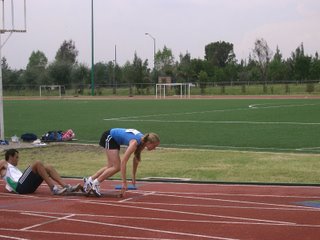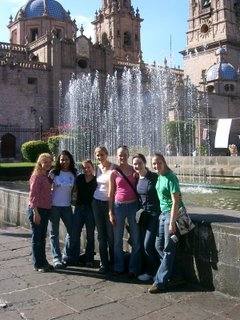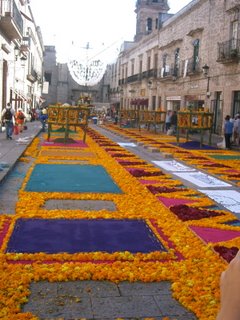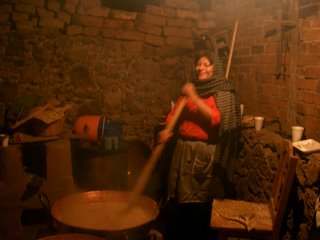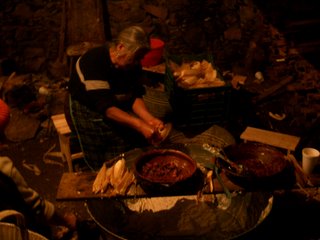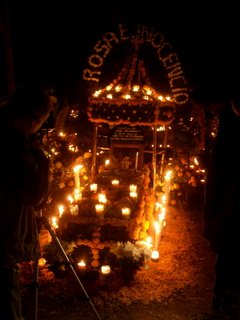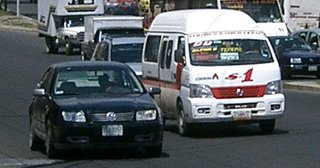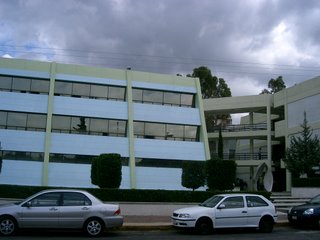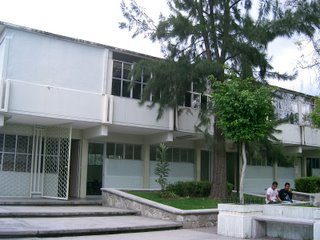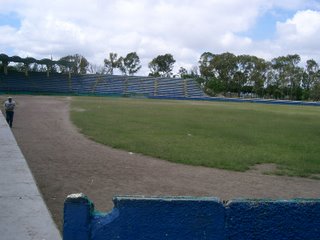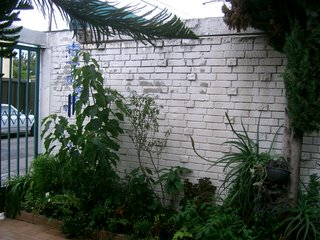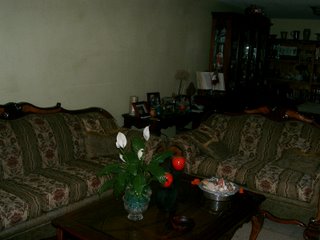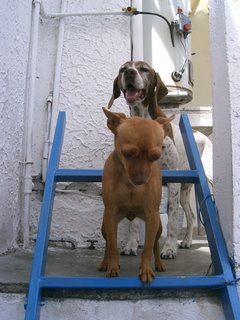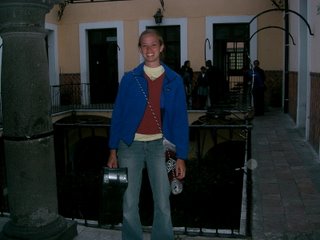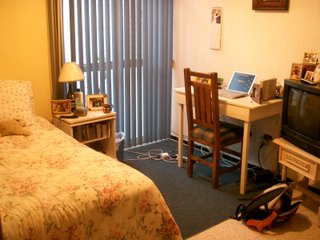This past week, my astronomy hopes were filled. The engineering and main building stage of the new telescope, the Large Millimeter Telescope, is now finished and this week was the inauguration. All week there were astronomy talks at the INAOE (Instituto Nacional de Astrofísica, Óptica y Electrónica) and visits to the telescope, which is located on a dormant volcano in the Sierra Negra, about 2.5 hours away from the city of Puebla. I couldn’t go to the talks everyday because I still had class, but I did manage to go to one day of talks and to visit the telescope (thanks to arrangements made by my advisor).
On Tuesday, I went to the INAOE for the first day of talks. I caught the INAOE bus from the center of Puebla to Tonantzintla, where the institute is located. The bus arrived about halfway through the first talk, so I unfortunately didn't really understand what it was about. I did however, have a pleasant bus ride with two astronomers, a Cuban and an Italian. After the first talk, I met a representative from the Washington DC center of NASA as well as two UMass professors, one of which is the scientific director of the telescope for UMass. The other remembered that my professors had mentioned I am here and was very friendly. When he discovered I didn't have an invitation to the inauguration dinner Wednesday night (a formal, invitation-only event hosted by the govenor of Puebla), he made it his business to get one for me!
The UMass head of the project gave the next talk about the scientific capabilities of the telescope. I really enjoyed it and it was exciting to hear about what it's going to be able to do!! After the talk, I spoke again with the Cuban astronomer. Earlier in the bus, we had been talking about how much I like Puebla, my hope to stay in Mexico this summer to do astronomy research, and plans to network during the events. With all this in mind, he introduced me to the director of the INAOE and the Mexican director of the telescope project. The director of the INAOE was really excited about the idea of me working on research there this summer and introduced me to the director of astrophysics. Apparently they have some sort of undergraduate program with a specific school so at least they are used to the idea of having undergrads work there. The director of astrophysics said he would talk to some of the researchers to see what he can recommend and then will get back to me with their names. I'll then have to set up appointments with them to see if I like any of the projects and if I can be incorporated. I hope something works out!
After lunch, I went on a tour of the INAOE labs with quite the eclectic group: two Russians, one of whom spoke English and the other I'm not sure about, the Cuban, who spoke Spanish and Russian, the NASA representative, who only spoke English, and me. The first stop on the tour was at the observatory there at INAOE. The technician there only spoke Spanish. I was translating to English for the NASA rep. I thought the Cuban was also translating to English for the Russians, but then I realized I didn't understand what he was saying: he was speaking Russian! It was quite the trip! Fortunately, at the other stops on the tour, the guides spoke English so there weren't so many languages going on at once.

Our touring group, two Americans on the left, two Russians in the center, and a Cuban, all getting along perfectly, of course, despite our governments' policies.
We also got to see the semi-conducting and circuit lab and two projects the INAOE is working on for the Mexican Navy. We couldn't believe they just let us in and explained the navy projects to us! I don't think that would ever happen in the US. One of the projects is an observation and tracking instrument to mount on boats. It was pretty neat to see the actual instrument swiveling all around and then to see the control board and see what the instrument was seeing, track an object, zoom in and out, and measure the distance to the pyramid in Cholula from there. It's sad to think what the project will be used for, but the science was neat to see. The other project was a system for guided missiles. Both projects will be the first of their type to be produced here in Mexico. Apparently the projects themselves are not secret, only the software behind them.

The spy device for the Navy boats.
Our final stop was to see the huge measuring device they have for measuring the plates for the main mirror of the telescope, a machine for polishing the mirrors, a mold for the secondary mirror, and one of the sheets for the main mirror. Unfortunately we were pressed for time so we didn't get much of an explanation on how the measuring device works or details of the other things.

The measuring device

A sheet for the main mirror. The knobs below it are for hand tuning of its position, which I think means its curvature. The guide said they first position it with the knobs and then they use the measuring machine to do the final tuning.
Wednesday night I went to the official inauguration dinner for the LMT. It was quite the elegant affair. It was in the covered patio of a museum in Puebla and there were tons of people. The attire varied from men in black suits and women in gala dresses to men in simple button down shirts and women in suit pants and blouses. The Mexican director of the project, the Chancellor of UMass, the director of the INAOE, and the governor of Puebla all spoke. I thought the chancellor’s speech was the most interesting. He spoke in Spanish, which impressed all the Mexicans at my table. Since, as he said, he's not a scientist, his speech focused on the more human aspects of the project. The speech was very well written and was more of a literary work than a "pat on the back, let's all cheer and recognize how great Mexico is" type of speech, which is what the rest of them (appropriately) were. The chancellor's speech was delightful to the ear, full of description and emotion, and rather poetic. I really enjoyed it.
In addition to the speeches, we watched some videos about the project, some more informational than others. The least informational and most patriotic of the videos was one fireworks being shot off all around the telescope. It was a bit strange, but quite festive. The dinner was elegant and I sat at a table with a man from the Mexican Marines and several scientists who work at the INAOE.
Yesterday (Friday) was the most exciting day of inauguration events for me because I went to see the telescope! When we arrived in the little town at the base of the mountain, the top of the mountain was totally covered in clouds. Before we started our ascent we stopped at a school and got to look at a drawing contest the elementary school had had of pictures of the telescope. It was neat to see the children's drawings. The school apparently took them up to the site to see it up close.

One of my favorite drawings; it shows two concepts of astronomy in Mexican history.
After charging up on coffee, we got into the 4-wheel drive vans and started up the switchbacks, rising from about 10,000 feet to the top at a little over 15,000 feet. We quickly entered into the clouds. Upon our arrival at the summit, we could hardly make out the telescope the clouds were so thick. The workers distributed hard hats to everyone and we waited to get the "ok" to enter the telescope.

The telescope, barely visible through the clouds when we arrived.
Once we received the “ok”, we entered into the base of the LMT, into the subterranean level. Inside we saw the tertiary mirror, all wrapped up in protective materials, the secondary mirror, not so protected and the dormitory rooms.

The convex, secondary mirror. This mirror, once mounted, will be able to move to allow astronomers to point at different parts of the sky without having to move the entire telescope.
The dorm rooms can be closed off from the rest of the rooms and they will eventually be oxygen-controlled. The idea isn't that scientists will be up there long enough to need the rooms, a 10 hour shift is the maximum people are allowed because of the altitude, but in case there is a storm and it's not safe to come down or if someone isn't doing well because of the lack of oxygen, the rooms are there where they can sleep, make food, etc. The dormitory consisted of two bedrooms, each with several beds and bathrooms, a nice large kitchen, and a couple conference or multipurpose rooms.
I asked the guide about how the workers manage now with the lack of oxygen. I was happy to hear that many of the construction workers come from the towns around the mountain, where the people are already adapted to high altitudes. They received training to be able to do the specialized construction work at that altitude. It was nice to hear how the project has benefited the communities in the area, providing jobs and skills that will hopefully help the people find better jobs in the future.
After looking at the living spaces, we got to go up the second floor, which is even with the ground outside.

Me inside the telescope with the stairs behind me.
There we saw the motors and track to move the telescope in 360 degrees azimuth.

Motors and track.
Our guide told us that the whole structure is so well engineered that a single person can move the entire telescope around, just by attaching a rope and pulling. The UMass project director was there and informed us that earlier that morning they had successfully moved the scope around 360 degrees in both directions for the first time. They were doing the final preparations to test the altitude movement after we left. Exciting!
Because the astronomers were working in the control room, we didn't get to go up any higher inside the telescope. We went back outside and we saw one of the model panels they were installing in the primary mirror so they could test the movement without actually having the real panels in place. From what I understood, the interior two rows of panels for the primary mirror are the real ones. Outside of that, they are installing model panels of similar weight so they can do tests of motion. They were also pouring, or had already poured, I wasn't sure which, a special, super heavy concrete, into the area directly below the primary mirror to act as a counterweight to the huge disk. President Fox is going to the telescope next Wednesday and they are hoping to be able to make an observation for him. They have a camera rigged up where the secondary mirror will eventually be.
Just before we left, the clouds cleared just enough around the telescope that we could actually see the whole thing, clearly for a couple minutes, though we still couldn't see anything around the mountain except clouds.

Part of the telescope. You can see a person on the balcony on the right side, which gives a nice size comparison.

Me in front of the telescope.

Workers going up to work on installing the plates to the primary mirror in the “elevator,” ie the crane.

A sketch of my understanding of the inside of the telescope. If you "click" on this image you should be able to see a larger version in which you can actually see and read it.
We drove back down the mountain, through the clouds, feeling the air get thicker with ever turn.

The switchbacks as we headed down the mountain in the clouds.
I had a wonderful time at each event and it was such an honor to be present during the celebration of such a huge scientific project taken on by Mexico. It was great to meet so many scientists from around the world and to talk astronomy with them. And, to top it all off, I didn't even get altitude sickness (I think living and running at over 7,000 feet probably helped with that)!


